Teaching Materials Reviews - Methods and Aids |
|||
by
John M. Zeigler, Ph.D. |
| T | |
eaching Materials Reviews - Methods and Aids
- Kinder-Keyboard, Moppets' Rhythms and Rhymes, Music For Moppets by Helen and Robert Pace
- The Contemporary Piano Method by Margaret Brandman
- K.A.C. Music Assignment Journal by Karen Celella
- To Hear Ourselves As Others Hear Us by James Boyk
- How To Get To Carnegie Hall - Weekly Music Practice Organizer by Diane Wachsmann
- At The Beginning - Teaching Piano to the Very Young Child by Rhoda Rabin
Kinder-Keyboard
Moppets' Rhythms and Rhymes
Music For Moppets
by Helen and Robert Pace
These three books are a great resource for teaching pre-schoolers and kindergartners. They are parts of the "Pace Method," which has an extensive series of books for both children and adults.
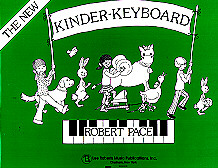 Kinder-Keyboard can be used for private teaching
or as part of a music program in a nursery school, pre-school or kindergarten. The music
in Kinder-Keyboard is fun, yet challenging. Our students that we did a "test
drive" with found this music "not stupid" and "not like for
babies." The music in Kinder-Keyboard is designed to give early,
interrelated musical experiences with melody, harmony and rhythm in various simple forms
as necessary pre-requisites for continued lessons and enjoyment of music throughout life.
Concepts covered in Kinder-Keyboard include finding groups of two and three black
keys on the piano, comprehending and following the contour (shape) of a melodic line, by
first singing the melody and then shaping it in the air. Students also learn the musical
alphabet, flats and sharps, the grand staff, concepts of musical dynamics, without
recourse to the unfortunate and pedagogically unsound approach of position playing. The
avoidance of position playing is a major recommendation for this method over many other
methods for younger students. Musical question and answer is done in such a clever way
that students do not realize what important and often difficult concepts they have just
learned.
Kinder-Keyboard can be used for private teaching
or as part of a music program in a nursery school, pre-school or kindergarten. The music
in Kinder-Keyboard is fun, yet challenging. Our students that we did a "test
drive" with found this music "not stupid" and "not like for
babies." The music in Kinder-Keyboard is designed to give early,
interrelated musical experiences with melody, harmony and rhythm in various simple forms
as necessary pre-requisites for continued lessons and enjoyment of music throughout life.
Concepts covered in Kinder-Keyboard include finding groups of two and three black
keys on the piano, comprehending and following the contour (shape) of a melodic line, by
first singing the melody and then shaping it in the air. Students also learn the musical
alphabet, flats and sharps, the grand staff, concepts of musical dynamics, without
recourse to the unfortunate and pedagogically unsound approach of position playing. The
avoidance of position playing is a major recommendation for this method over many other
methods for younger students. Musical question and answer is done in such a clever way
that students do not realize what important and often difficult concepts they have just
learned.
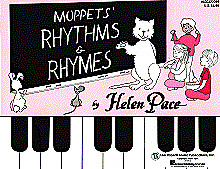 Moppets' Rhythms
and Rhymes is a collection of original game-songs set to strongly rhythmical verses,
for children ages 5-7. This book should be used only for groups of at least 4 children.
Rhythms and Rhymes focuses on strengthening the student's innate sense of rhythm and their
understanding of melodic direction. A great deal of time is spent making sure that
children understand simple rhythms through body movements, the use of rhythm instruments,
and rhythmical poems and games, which are often built around Mother Goose poems. Also
included are aspects of music such as lines notes, space notes, treble clef, bass clef,
steps and skips, faster and slower notes. Major and minor sounds are also touched upon.
The songs are delightful; the students who used this book enjoyed the songs and the things
to do with the music.
Moppets' Rhythms
and Rhymes is a collection of original game-songs set to strongly rhythmical verses,
for children ages 5-7. This book should be used only for groups of at least 4 children.
Rhythms and Rhymes focuses on strengthening the student's innate sense of rhythm and their
understanding of melodic direction. A great deal of time is spent making sure that
children understand simple rhythms through body movements, the use of rhythm instruments,
and rhythmical poems and games, which are often built around Mother Goose poems. Also
included are aspects of music such as lines notes, space notes, treble clef, bass clef,
steps and skips, faster and slower notes. Major and minor sounds are also touched upon.
The songs are delightful; the students who used this book enjoyed the songs and the things
to do with the music.
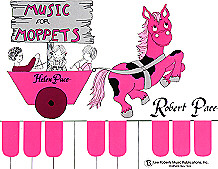 Music For Moppets can be used for group or private
teaching situations. It is geared for students ages 4-6 and stresses not only learning the
nomenclature of music, but acquiring the basic music skills to help the student express an
innate love of music. This book teaches about the piano, as well as musical concepts
such as high and low, question and answer, pentatonic scales, and melodic lines.
Music For Moppets can be used for group or private
teaching situations. It is geared for students ages 4-6 and stresses not only learning the
nomenclature of music, but acquiring the basic music skills to help the student express an
innate love of music. This book teaches about the piano, as well as musical concepts
such as high and low, question and answer, pentatonic scales, and melodic lines.
A highly instructive and helpful teacher's manual is available for each book in this series. The teacher's manuals contain precise and clear directions on how to deal with each piece of music in the student's book. The teacher's part with each piece of music is clearly written and has a detailed analysis of the particular concept that the student is to learn. Also included are a specific outline of how each lesson should be practiced at home, bare-bones examples of studio policies, and a good discussion of the importance of positive involvement of parents in the student's lessons and daily piano playing time at home. We found this approach to piano time at home right on the money.
All three of these books present a very highly organized and efficient approach to teaching preschoolers. While the teacher should read the teacher's manuals carefully so as to understand the philosophy of the books and how to teach the musical concepts presented, we strongly recommend them for teachers of pre-schoolers. Although no book or set of books is right for all students, these books are pedagogically very sound, with exceptionally well-done teacher's manuals that provide great support for the teacher.
Kinder-Keyboard by Robert Pace, ISBN 0-7935-8070-6. List price $8.95.
Teacher's Manual, ISBN: 0-7935-8071-4, $5.00
Moppets' Rhythms and Rhymes by Helen Pace, List price $6.95. Teacher's Book
$3.50
Music For Moppets by Helen and Robert Pace, ISBN 0-7935-5853-0, List price
$7.95. Teacher's Manual.$7.00
Lee Roberts Music Publications, Inc. Chatham, New York, Distributed by Hal Leonard
Corporation, 7777 West Bluemound Rd., P.O. Box 13819, Milwaukee, WI 53213. Phone:
414-774-3630. Fax: 414-774-3259. WWW: http://www.halleonard.com.
E-mail: halinfo@halleonard.com.
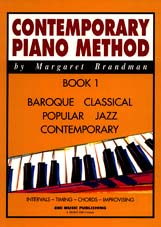 The Contemporary Piano Method
The Contemporary Piano Method
by Margaret Brandman
The Contemporary Piano Method, subtitled "A Comprehensive and Balanced
Approach to Keyboard Study", is designed to be a complete course ranging from the
elementary stages through the upper intermediate levels and beyond. The basic method
consists of five volumes: Junior Primer, Book 1, Books 2A and 2B, and the more advanced
Books 3 and 4.
Piano methods vary considerably in approach. Some consist largely of repertoire and leave
the teacher free to apply his or her own way of explaining technical fundamentals such as
hand position and note reading; others put the teacher in a virtual strait jacket, rigidly
prescribing practically every word and movement at every step of the way. The Brandman
books seem to aim at a compromise: the Junior Primer, for example, includes a seven-page
supplement called Guide Notes for the Teacher--essentially footnotes to selected pages of
the Primer giving amplifications and suggestions plus fourteen duet parts for the simpler
student pieces--but use of the supplemental materials is optional.
The Junior Primer is aimed at very young children, who are guided along by Dexter the
Koala cub (Ms. Brandman lives and teaches in Australia). Beginning with Book 1, however,
Dexter disappears and we are presented with a thorough, no-nonsense approach that moves
along at a pace some might find a bit daunting. This single volume begins with
"meeting a piano for the first time" (with photos of a working piano action),
basic posture and hand position, and proceeds all the way through reading, time values,
transposition, legato and staccato, hand crossings, phrasing, dynamics, ornaments,
terminology, accidentals, the chromatic scale, and all the major scales, chords and key
signatures. Often it seems as if new concepts are presented rapid-fire before the student
has time to digest the old ones, but it should be noted that there are a number of
supplementary materials designed to be used with the basic course: a Companion Workbook
for Book 1 is available, and The Contemporary Piano Method on Video features the
author demonstrating technique, reading and transposition skills, clapping techniques for
rhythm, and a system of using different colors for note values. In addition, finger
technique, reading, transposition and improvisation can be augmented with several other
volumes entitled Daily Dexter Flexers, Dexter's Easy Piano Pieces, Hot Trax and It's Easy
to Improvise, all designed to interact with the basic course; Book 1 itself has a single
page of teacher guide notes at the end. We can also report here that Book 1 will, like
Book 2, be divided into two volumes in its next edition. Another volume, Teacher's
Handbook, is unfortunately no longer available; it would seem highly valuable in a course
which interweaves so many skills, and we hope for its return.
The overall intent, then, is to allow the teacher considerable leeway in the amount of
time spent on each concept, depending on the degree of experience and aptitude of the
student. One of the fundamental elements underlying the entire method is the teaching of
note reading by interval recognition instead of letter names applied to lines and spaces,
an approach pioneered in this country by Frances Clark. It facilitates reading by allowing
the brain and eye to skip the mental detour involved in thinking of letter names, and
develops a procedure essential to quick sight reading and especially transposition. Ms.
Brandman is definitely of the school that believes piano students should be able not
merely to play learned pieces well, but to sight read, transpose, and improvise. The
Contemporary Piano Method offers ample exercise in all these skills.
Books 2A and 2B continue to stress the interval method of reading
"through encouraging the student to view sections as larger recognizable units";
minor scales and four-note chords are introduced as well, along with more difficult
exercises such as double notes and skips, and more advanced repertoire. Ms. Brandman is
also a great believer in the power of associating different elements of a skill or concept
with colors, and this learning technique appears throughout the course. We must admit,
however, to being a bit put off by the use of rhythm diagrams "to be coloured
in"; such activity seems more suited to the primer stage and is not too likely to
appeal to the average American teenager. It might also be noted that British Commonwealth
terms like "crotchet" (quarter note) and
"semiquaver" (16th) are standard fare, in case these terms are unfamiliar to
you.
Books 3 and 4 take the student into advanced levels which include
asymmetrical meters; ninth, eleventh, thirteenth and added-tone chords; scales in thirds,
sixths and tenths; modes, polychords and panchromaticism; and repertoire which reaches the
level of The Well-Tempered Clavier and the easier Chopin etudes, and encompasses a number
of different styles including jazz. Many of the compositions are the author's own.
Margaret Brandman has also published a comprehensive course in theory and ear training,
complete with workbooks and cassettes, as well as much additional repertoire, CD's and
other materials. Her web site (www.healey.com.au/~jazzem)
gives generous descriptions and samples, both visual and aural, of all her work.
The Contemporary Piano Method is endorsed by no less an authority than Maurice
Hinson and is as complete a piano course as you'll find anywhere; we find it admirable and
stimulating, but it makes great demands on both teacher and student. Is it possible that
Australians expect more from their students than we do? Maybe we could learn something
from them.
William Leland and Melba Halamicek
Contemporary Piano Method by Margaret Brandman. Junior Primer and Books 1, 2A,
2B, 3 & 4: List Price: Junior Primer $12.95 (Aus); all other volumes $14.95 (Aus)
(Junior Primer has no ISBN) ; Book 1: ISBN 0 86947 016 7. Book 2A: ISBN 0 86947 034 5.
Book 2B: ISBN 0 86947 039 6. Book 3: ISBN 0 86947 424 3. Book 4: ISBN 0 86947 401 4. Music
Sales, Level 4, 30-32 Carrington Street, Sydney, NSW, 2000. Australia Web: http://www.geocities.com/margaretbrandman/edu.html.
E-mail: jazzem@healey.com.au. Distributors in
the USA: Santorella Music, Boston.
K.A.C. Music Assignment Journal
by Karen Celella
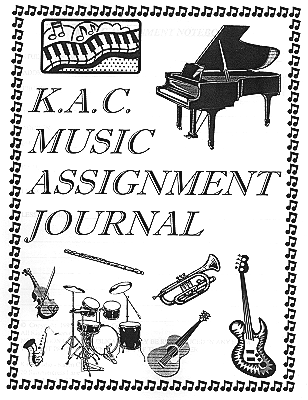 The K.A.C. Music Assignment Journal can be a
useful tool for organizing and helping a student with daily practice. It can also help
organize a teacher in getting precise data from their students on how their daily practice
day goes. In addition to serving as an organizational tool, it goes beyond that and
provides some elements of a concise reference work.
The K.A.C. Music Assignment Journal can be a
useful tool for organizing and helping a student with daily practice. It can also help
organize a teacher in getting precise data from their students on how their daily practice
day goes. In addition to serving as an organizational tool, it goes beyond that and
provides some elements of a concise reference work.
There are some very good and worthwhile ideas in these pages. Not only does this journal provide space for the student to write down such things, as metronome markings, etc. but also provides a a checklist for thoughtful practicing, including ideas about preparing the environment where one will practice, preparing music, preparing body, mind and, heart, listening, accomplishing goals and appreciating the hard work that the student has done in each practice session. K.A.C. Music Assignment Journal also gives tips on how to practice and how to use them correctly.
In addition to the practicing of repertoire, K.A.C. Music Assignment Journal also stresses incorporation of daily sight reading, technique, ear training, scales, chords, modes, arpeggios. It includes a very helpful description and spellings of chord types (including how to alter the specific tones of the chords to make them become different chords), major and minor key signatures, major scales, major cadences, harmonic minor scales, harmonic minor cadences, major and minor arpeggios.
K.A.C. Music Assignment Journal also embodies a description of metronome settings, musical eras, dynamic markings, the more ‘popular’ classical composers including their dates of birth and death, their era, nationality. There are places for students to write down their wish list of music that they would like to learn, keep track of their repertoire learned, staff paper, and notes and reminders from the teacher to the parents/students, including payment records.
The philosophy of this journal seems to be to provide 52 weeks of well-defined daily practice goals. The daily practice goals page consists of spaces to write down the dates for the 7 days of practice per week, technique, pieces, etc and also room to note the exact metronome speeds at which each piece or technical exercise is to be done for each day. This check list for thoughtful practice was very helpful. K.A.C. Music Assignment Journal also discusses the importance of having a physical environment arranged for focused practice, the idea of staying away from negative attitudes about practice, about listening to what is being practiced, about setting attainable goals for each practice session, and appreciating the small forward steps that have been taken in each daily practice session.
We would like to see Ms.Celella write a book about the ideas of healthy practice, expanding upon the ideas that are briefly, but well discussed in K.A.C. Music Assignment Journal. Although some teachers and students might find this approach to structured practice confining, we see K.A.C. Music Assignment Journal as a worthwhile tool to help get some students focused on organized practice.
K.A.C. Music Assignment Journal. List price: $10.00 for the standard edition
(30 -40 weeks), plus $2.00
S/H, $20.00 plus $2.00 S/H for the deluxe edition (52 weeks). Karen Celella, K.C.
Studio, 20 Summercress Lane, Coram, NY 11727. E-mail: KCelella2@aol.com
To Hear Ourselves As Others Hear Us
by James Boyk
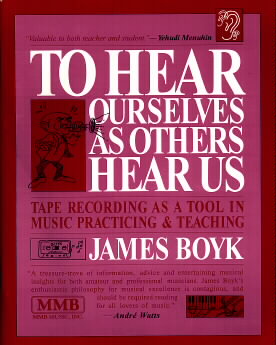 This brief book is
brief only in size. It is a giant-sized book in its insights and helpful hints for how to
play better via the vehicle of taping our own playing and performances. Mr. Boyk, Pianist
in Residence at the California Institute of Technology, is an accomplished and experienced
concert performer and recording artist; his hands-on experiences make this book even
better.
This brief book is
brief only in size. It is a giant-sized book in its insights and helpful hints for how to
play better via the vehicle of taping our own playing and performances. Mr. Boyk, Pianist
in Residence at the California Institute of Technology, is an accomplished and experienced
concert performer and recording artist; his hands-on experiences make this book even
better.
We especially liked the idea of singing phrases as a route to understanding the playing of phrases. I loved his lyrics for the Mozart Sonata in F, K. 332; they were a hoot! It was great to show my students that I (and Charles Ives!) am not the only teacher/performer who invents lyrics to go with her repertoire. I also liked the suggestion of dancing to the music and was most appreciative of Mr. Boyk's ideas of how to begin a performance.
Mr. Boyk also has many wonderful insights into positive and negative teacher/student relationships and performer/piano relationships. I also appreciated the sections devoted to the concept of outlining a piece of music, a very practical and pedagogically sound approach to learning and performing a piece of music. The book ends with an excellent analysis of recording equipment, how to get into the concept of low anxiety recording sessions, and actual recording advice. Again, the counsel was pedagogically sound and refreshing to read.
Bravo to Mr. Boyk for this little gem of a book. It is one that all piano teachers, students and parents should take the time to read and then read again. The insights and advice in this book are too many to skim through and too good to digest at only one exposure. We agree with Andre Watts in his cover recommendation that this book "should be required reading for all lovers of music."
To Hear Ourselves As Others Hear Us by James Boyk, list price $9.95, Published by MMB Music Inc., Contemporary Arts Building, 3526 Washington Avenue, Saint Louis, MO 63103-1019. Phone 314-531-9635, 800-543-3771. Fax 313-531-8384. E-mail: mmbmusic@mmbmusic.com WWW: http://www.amazon.com/exec/obidos/tg/detail/-/0918812879?v=glance
How to Get to Carnegie Hall
Weekly Music Practice Organizer
by Dianne Wachsman
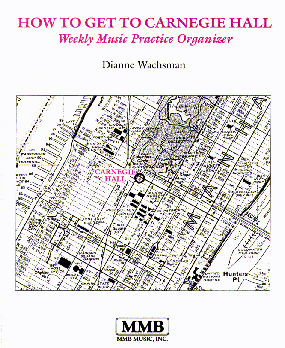 How to Get to
Carnegie Hall is a gem of a book specifically designed to help organize and structure
musical practice sessions. Whether it used by private music students and their teachers,
or for school orchestras, bands or chamber music ensembles, the student will benefit from
the organization that this book can bring to practice. Unlike some organizers of this
genre, How to Get to Carnegie Hall doesn't get so wrapped up in extensive details
of documentation of practice to the detriment of actual practice. Rather, it is
thoughtfully designed to bring the maximum amount of effort to bear on real,
effective practice.
How to Get to
Carnegie Hall is a gem of a book specifically designed to help organize and structure
musical practice sessions. Whether it used by private music students and their teachers,
or for school orchestras, bands or chamber music ensembles, the student will benefit from
the organization that this book can bring to practice. Unlike some organizers of this
genre, How to Get to Carnegie Hall doesn't get so wrapped up in extensive details
of documentation of practice to the detriment of actual practice. Rather, it is
thoughtfully designed to bring the maximum amount of effort to bear on real,
effective practice.
Each week's entries consist of two facing pages which open flat for easy access. The left page provides space to enter basic information about the week's practice sessions along with assignments, goals, and notes. The right page is a blank sheet of manuscript paper, which the teacher or student can use to literally make notations of exercises, theory, ear training or sight reading skills, etc. The left page is divided up into different sections. Each section deals with a specific of practice; for example, the Organizer is divided into the specific days of the week. Once these have been agreed upon by all involved parties, the student will circle those agreed upon days of practice. The teacher has space to write specific strategies for each individual piece of music. The Organizer also has space to keep track of the time allotment for each practice session. A thoughtful feature of this organizer is that it also has a specific space where the amount of time to be spent on each assignment can be written. We found this most helpful, as most students will tend to spend most of their practice time on one specific piece of music or exercise and run out of time for the remaining technique and/or repertoire assigned. As each assignment is practiced, there is room for the student to check off the day of the week when they practiced, providing a record of both the expectations and the reality of practice sessions. At the bottom of each page of the practice organizer is a large space for the teacher to make further notes or reminders for the student.
We deeply appreciated the section of the preface to How to Get to Carnegie Hall called A Note To Parents. This section stresses the importance of positive parental involvement in the child's musical education. The suggestions for parents to help their children were concise and based on a positive approach to helping their child in the study of music. It drove home a point about which we all need to remind ourselves - that the parents of our students need to be involved to make the learning process a positive, constructive experience. Bravo to Dianne Wachsman for identifying and articulating these needs.
While How to Get to Carnegie Hall might not apply to all students or in all teaching environments, it can be a great help to those students and/or parents who need more structure in their practice time. This reviewer would recommend it for students of all ages and levels. It is well worth the $9.95 price.
How to Get to Carnegie Hall - Weekly Music Practice Organizer by Dianne Wachsman. List price: $9.95. MMB Music, Inc, Contemporary Arts Building, 3526 Washington Ave., St Louis, MO 63103-1019 USA. Phone 314-531-9635, 1-800-543-3771 Fax 314-531-8384. e-mail: mmbmusic@mmbmusic.com. WWW: http://www.mmbmusic.com
At The Beginning - Teaching Piano to the Very Young Child
by Rhoda Rabin
 At The Beginning - Teaching Piano to the Very Young Child places the
emphasis where it should be placed - on the individual child’s learning process,
rather than the teaching method. Ms. Rabin stresses really knowing the art of teaching
music - communicating and caring first and foremost for the musical needs of the
individual student. We receive many e-mails from teachers wanting us to suggest a teaching
method; if you are a teacher or parent trying to evaluate the claims of various teaching
methods, you should get and carefully digest the contents of this book. Teachers, parents
and students of ALL ages can benefit from the gems of wisdom and philosophies of Ms.
Rabin.
At The Beginning - Teaching Piano to the Very Young Child places the
emphasis where it should be placed - on the individual child’s learning process,
rather than the teaching method. Ms. Rabin stresses really knowing the art of teaching
music - communicating and caring first and foremost for the musical needs of the
individual student. We receive many e-mails from teachers wanting us to suggest a teaching
method; if you are a teacher or parent trying to evaluate the claims of various teaching
methods, you should get and carefully digest the contents of this book. Teachers, parents
and students of ALL ages can benefit from the gems of wisdom and philosophies of Ms.
Rabin.
At The Beginning - Teaching Piano to the Very Young Child's chapters include:
- 1. Beginning at the Beginning
- 2. Art and the Art Habit
- 3. The Child
- 4. The Family
- 5. The Teacher
- 6. Fundamental Teaching Principles
- 7. Environment Strategies-Keyboard Geography and Ear-Training
- 9. Teaching Strategies- Rhythm and Reading
- 10. Teaching Strategies Technique and Performance
- 11. The First Lesson
- 12. Putting It All Together
The three very valuable appendices include Hello Everybody, Musical Games (the songs and the concepts) and Learning by Ear. Also at the end of the book is a bibliography of teaching materials and books and a reasonably complete index. It is illustrated with drawings of children involved in the activities written about in the book. Its comb binding helps the book lie flat for frequent and easy reference.
We especially appreciated focus of this book on placing the needs of the student first and foremost in the teaching, rather than force-feeding a particular method of teaching. Rabin stresses the importance of sensitivity, skill and the ability to empathize and communicate with the student . Even more importantly, she emphasizes that teaching students inside a constrictive, inflexible method will "plane away a child’s uniqueness, leaving behind shavings that represent some of the best in each emerging mind." Instead, she replaces the need for methods, lists of restrictions, and rules, with one simple truth:"just as there is no single definition of intelligence, there is no typical or average child."
Ms. Rabin uses a ‘three-legged stool’ metaphor to explain the relationship between the teacher, student, and parents. All three legs need to be secure and balanced to provide the greatest benefit to the student. She stresses a positive parental involvement with the student’s lessons with open communication about the progress of the student and ways to make lessons a positive growth experience. She strongly encourages parents to have their children start their lessons, or their "art habit", early in life, "before the other attractive elements of early life (school activities, clubs and scouting, sports and video games) take too strong a hold." The art habit, that is the love for and practice of art, once rooted in a child’s spirit, is not easily dislodged. Ms. Rabin also encourages the study of piano by younger students as a way of teaching children that the acquisition of routines helps realize important objectives. We teach a child to play piano with the objective of instilling the lifelong appreciation of beauty through musical expression. Ms. Rabin feels that the very young child can begin piano lessons without any previous music readiness classes.
Each page of At The Beginning - Teaching Piano to the Very Young Child contains wonderfully positive ideas, tips and philosophies about teaching students. She offers some wonderful guidelines for fundamental teaching principles: ‘Let the relationship with the child come before the method". ‘Let the sound of music come before anything else’. ‘Know your goals both short and long range- and have a systematic way to review progress.' `Always show what you mean.' `Advance slowly.' Deal with difficulties by isolating problems, correcting them, then relating them to the total musical concept. Keep the lesson simple, and always leave your students eager for more. Plan for success and expect it.
Ms. Rabin emphasizes that teachers need to keep expanding, year by year, in a constant process of discovery and growth. She urges teachers to keep current on ‘the growing body of research from all the fields of education and behavioral science that can help teachers better understand the way young students learn." Ms. Rabin shows wonderful insight into the importance of the beginning student’s teacher. The beginning piano student’s teacher can make or break a child’s love of music and establishment of the art habit. Therefore, she argues that we should make sure that parents, other educators and piano teachers alike understand that getting the cheapest, and often the most inexperienced, piano teacher for the beginning student is NOT the way to go. It is inconsequential if the student becomes a concert pianist or not; what counts is that the student learns from positive growth experiences to play the piano, understand musical concepts, develop the art habit, and then apply these experiences and positive habits to life’s challenges.
In graduate school, we had a piano pedagogy teacher who insisted that we carefully explore and analyze ALL existing piano teaching methods. She felt that those of us who would be teaching should know as much as possible about available teaching methods, so that we would have the tools at hand to make the experience for the student as positive, rewarding and fulfilling as possible, no matter what their level of knowledge, previous training, or experience. At The Beginning - Teaching Piano to the Very Young Child is a welcome clarion call to the same student-centered philosophy of teaching.
Bravo to Ms. Rabin for writing At The Beginning - Teaching Piano to the Very Young Child. We believe that this book should be a valuable resource for many piano pedagogy classes at both the undergraduate and graduate levels. It should also be a permanent part of each piano teacher’s library. .
At The Beginning - Teaching Piano to the Very Young Child by Rhoda Rabin. List Price: $30. ISBN 0-02-872066-0. Library of Congress Catalog Card Number: 95-34460. Schirmer Books - Prentice Hall International - Schirmer Books, An Imprint of Simon and Schuster Macmillan, 866 Third Avenue, New York, NY 10022. WWW: http://www.amazon.com/At-Beginning-Teaching-Piano-Young/dp/0028720660
Last updated: 02/09/24

